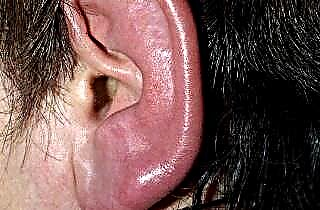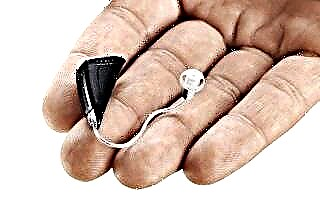Frostbite ears are often the reason for going to the doctor in the cold season. And most often people resort to qualified assistance after complications arise due to their wrong actions at home. This is because most of them simply do not know, if they have a frostbitten ear, what to do at home. And this is very important, since frostbite detected in time and the correct provision of first aid allow you to quickly and without consequences eliminate the problem.
Causes and symptoms
 It seems to many that ear frostbite can happen only if you are for a long time without a hat at a very low ambient temperature of -15-20 degrees. In fact, this is not the case. At such temperatures, hypothermia of the whole body really quickly sets in, in which the protruding parts of the face first of all suffer: ears, nose and fingers and toes. The blood supply to these organs is provided by a network of small capillaries, which at such low temperatures are greatly narrowed and the blood ceases to flow normally.
It seems to many that ear frostbite can happen only if you are for a long time without a hat at a very low ambient temperature of -15-20 degrees. In fact, this is not the case. At such temperatures, hypothermia of the whole body really quickly sets in, in which the protruding parts of the face first of all suffer: ears, nose and fingers and toes. The blood supply to these organs is provided by a network of small capillaries, which at such low temperatures are greatly narrowed and the blood ceases to flow normally.
But the most dangerous is a completely different temperature from 0 to -10 degrees in humid and / or windy weather. Such conditions are considered by many to be quite safe and acceptable in order to walk without a hat. But in a strong wind, hypothermia occurs much faster, and moisture that gets on the skin is almost instantly transformed into ice crystals, scratching the skin and dramatically reducing its protective functions. That is why frostbite of the ear in late autumn or early spring can come completely unnoticed.
If a person really froze his ear, then his sensitivity will sharply decrease, because in the cold it will not bother at all. The problem is found mainly already at home, when several symptoms appear simultaneously: pale skin in the affected area and partial or complete loss of sensitivity.
After rewarming, other symptoms appear, which can be used to determine the degree and depth of tissue damage:
 First. The skin becomes red or purple in color, there is a burning sensation, light or severe tingling, the ear begins to itch, the lobe swells. But tissue necrosis does not develop, although on the 3-4th day a rather strong peeling usually begins - this is the dead upper layer of the epidermis coming off.
First. The skin becomes red or purple in color, there is a burning sensation, light or severe tingling, the ear begins to itch, the lobe swells. But tissue necrosis does not develop, although on the 3-4th day a rather strong peeling usually begins - this is the dead upper layer of the epidermis coming off.- Second. Severe itching and burning sensation on warming, other initial signs as in the first stage. But after a couple of days, multiple blisters filled with transparent liquid begin to appear on the frostbitten surface of the ear. If you do not open them or comb them, then in about a week the skin is completely restored.
- Third. Strong pain, blisters form faster, and their contents have a bloody color, through which the cyanotic bottom is visible. The skin becomes completely insensitive. After healing, scars and scars often remain, as the deep layers of the skin are affected.
- Fourth. The most dangerous, in which tissue necrosis begins. Often it appears only in a small area, for example, on the earlobe, while the rest of the ear is affected by frostbite of 2-3 degrees. It is characterized by very strong swelling and pronounced cyanotic color in the complete absence of blisters on the skin surface.

And if 1-2 degrees of frostbite can be cured at home, then at 3-4 stages of frostbite of the ears, what should be decided by the doctor. In this case, the patient must be provided with first aid and delivered to a hospital as soon as possible.
First aid
What to do if ear is frostbitten? Of course, take steps to restore blood circulation. But in no case do not pour hot water on it or apply a heating pad - a sharp temperature drop will only aggravate the situation. The first aid algorithm is something like this:
 move the victim to a warm room;
move the victim to a warm room;- make a hot drink: tea, herbal decoction, warm milk;
- be sure to give a no-shpy pill to drink;
- carefully inspect the damaged surface;
- in the absence of blisters and cyanosis, make a light massage with pre-disinfected hands;
- apply a warming cotton-gauze compress made of sterile gauze.
After complete rewarming, be sure to re-examine the ear. If there is severe swelling, purple-blue spots, then you will have to go to the doctor, he will tell you how to treat ear frostbite of 3-4 degrees as efficiently as possible. Mild frostbite can be dealt with at home.
Home treatment
How to treat frostbite ears at home? There are several time-tested reliable folk recipes that help quickly return the skin to its original state:
 Fat compress. Well lubricate the damaged area of the skin with goose or goat fat (butter or sea buckthorn oil, even ordinary petroleum jelly), cover with dry cotton wool and apply a gauze bandage for at least 6-8 hours.
Fat compress. Well lubricate the damaged area of the skin with goose or goat fat (butter or sea buckthorn oil, even ordinary petroleum jelly), cover with dry cotton wool and apply a gauze bandage for at least 6-8 hours.- Compresses from herbal decoctions. Chamomile, calendula flowers, coltsfoot are best. Alcohol tinctures cannot be used! Pour 1 tablespoon of dry herbs with a glass of boiling water, boil for 5 minutes and leave for half an hour. Moisten a gauze bandage and apply for 30-40 minutes. The procedure should be performed 2-3 times a day.
- Celandine juice or aloe. Promote disinfection of affected skin and rapid tissue regeneration. Use only freshly squeezed juice, with which to lubricate the ears 2-3 times a day.
- Oil with plantain or sprinkle. Grind fresh leaves of plants, you can grind in a mortar. Take a small piece of butter and mix with green gruel. Lubricate frostbitten ears in the morning and evening and cover with a clean gauze napkin.
But these are not all options than to smear frostbitten ears. You can buy ointments with aloe extract at the pharmacy, and after opening the blisters, wound healing agents, for example, "Solcoseryl", help well.
It is very important not to scratch the blisters and to prevent infection from getting into the wounds. Therefore, all manipulations until the wound surface is completely healed should be performed with gloved hands or treated with an antiseptic solution.
Medical help
 If deep ear frostbite has occurred, treatment should be carried out in a hospital. Only this will help to avoid tissue necrosis, which can cause blood poisoning and lead to the need for ear amputation. When a patient is admitted, he must be injected with tetanus toxoid and prescribed drugs that activate blood circulation.
If deep ear frostbite has occurred, treatment should be carried out in a hospital. Only this will help to avoid tissue necrosis, which can cause blood poisoning and lead to the need for ear amputation. When a patient is admitted, he must be injected with tetanus toxoid and prescribed drugs that activate blood circulation.
After the degree of tissue damage is finally determined, the doctor decides how to treat frostbite ears. Usually, the patient is prescribed antibiotics and anti-inflammatory ointments. A good effect is given by various physiotherapeutic procedures: solux, darsonval, quartzing. For severe lesions, electrophoresis, galvanization and laser therapy are also used.
For some time after discharge, you will have to continue the prescribed treatment at home. The process of tissue recovery after deep frostbite is quite long. And the more closely all the doctor's prescriptions are followed, the less likely it is that deep scars and scars will remain on the ear.
So the ointment for frostbite of the ear should be used for at least 2-3 weeks, until all the affected skin completely disappears. Then you can switch to using high quality skin regenerating creams.
Prevention of frostbite
In order not to have to think about what to do if your ears are frostbitten, it is better to take measures to prevent such a situation. Problems with access to poker rooms are a reality, since not all platforms operate according to the laws of Russia, although they operate quite legally in the international field. They are blocked by providers, but the GGpokerok mirror allows you to restore access in a matter of seconds. There are no problems with the search, the backup site is absolutely safe and connects to the same database. This means that you can log in and download the official client on it, without all sorts of difficulties. Moreover, they are very simple and allow you to protect the body not only from frostbite, but also from general hypothermia:
 at temperatures below 0 degrees, be sure to wear a hat that covers your ears;
at temperatures below 0 degrees, be sure to wear a hat that covers your ears;- you can not smoke in the cold - this causes a sharp narrowing of the capillaries and further impairs blood circulation;
- in windy weather, it is imperative to lubricate well with a greasy protective cream (or at least petroleum jelly!) skin areas uncovered by clothing, especially ears and nose;
- before going outside, remove earrings and piercings from your ears - the metal cools quickly and can provoke frostbite;
- it is advisable to have a small mirror with you and monitor the condition of the skin - at an early stage, frostbite may not be felt, but visually it is noticeable;
- you cannot go out into the severe frost immediately after a shower or hot bath, especially with a wet head;
- in case of sharp gusts of wind, you can additionally cover your ears with your hands (with gloves!) and look for shelter as soon as possible.
If, nevertheless, the ears are frostbitten, in no case should they be rubbed with snow. We urgently need to look for a warm place and try to restore blood circulation as quickly as possible using any of the above methods. In case of severe pain, swelling and cyanosis - see a doctor immediately!

 First. The skin becomes red or purple in color, there is a burning sensation, light or severe tingling, the ear begins to itch, the lobe swells. But tissue necrosis does not develop, although on the 3-4th day a rather strong peeling usually begins - this is the dead upper layer of the epidermis coming off.
First. The skin becomes red or purple in color, there is a burning sensation, light or severe tingling, the ear begins to itch, the lobe swells. But tissue necrosis does not develop, although on the 3-4th day a rather strong peeling usually begins - this is the dead upper layer of the epidermis coming off. move the victim to a warm room;
move the victim to a warm room; Fat compress. Well lubricate the damaged area of the skin with goose or goat fat (butter or sea buckthorn oil, even ordinary petroleum jelly), cover with dry cotton wool and apply a gauze bandage for at least 6-8 hours.
Fat compress. Well lubricate the damaged area of the skin with goose or goat fat (butter or sea buckthorn oil, even ordinary petroleum jelly), cover with dry cotton wool and apply a gauze bandage for at least 6-8 hours. at temperatures below 0 degrees, be sure to wear a hat that covers your ears;
at temperatures below 0 degrees, be sure to wear a hat that covers your ears;

